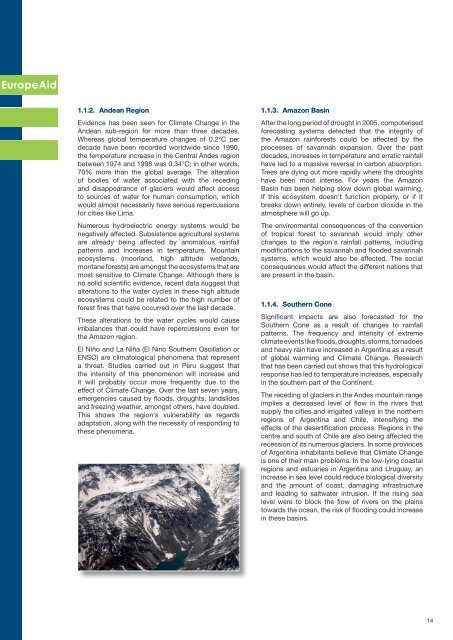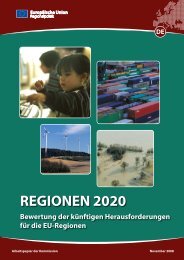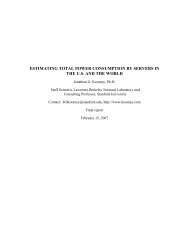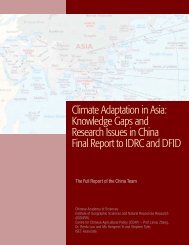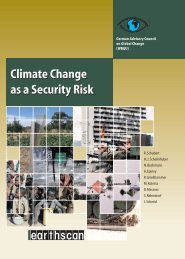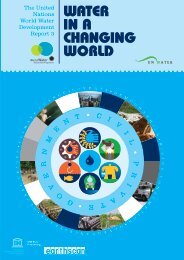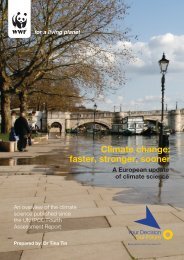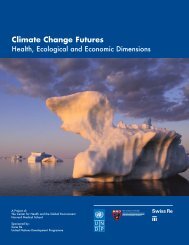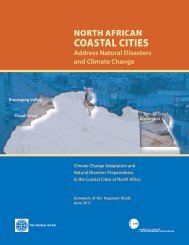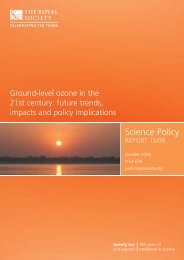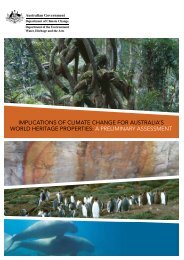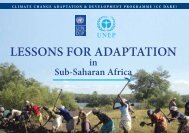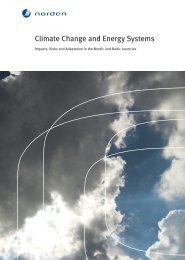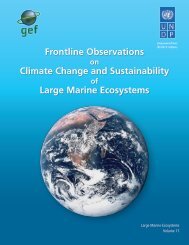Climate Change in Latin America - European Commission
Climate Change in Latin America - European Commission
Climate Change in Latin America - European Commission
Create successful ePaper yourself
Turn your PDF publications into a flip-book with our unique Google optimized e-Paper software.
1.1.2. Andean Region<br />
Evidence has been seen for <strong>Climate</strong> <strong>Change</strong> <strong>in</strong> the<br />
Andean sub-region for more than three decades.<br />
Whereas global temperature changes of 0.2°C per<br />
decade have been recorded worldwide s<strong>in</strong>ce 1990,<br />
the temperature <strong>in</strong>crease <strong>in</strong> the Central Andes region<br />
between 1974 and 1998 was 0.34°C; <strong>in</strong> other words,<br />
70% more than the global average. The alteration<br />
of bodies of water associated with the reced<strong>in</strong>g<br />
and disappearance of glaciers would affect access<br />
to sources of water for human consumption, which<br />
would almost necessarily have serious repercussions<br />
for cities like Lima.<br />
Numerous hydroelectric energy systems would be<br />
negatively affected. Subsistence agricultural systems<br />
are already be<strong>in</strong>g affected by anomalous ra<strong>in</strong>fall<br />
patterns and <strong>in</strong>creases <strong>in</strong> temperature. Mounta<strong>in</strong><br />
ecosystems (moorland, high altitude wetlands,<br />
montane forests) are amongst the ecosystems that are<br />
most sensitive to <strong>Climate</strong> <strong>Change</strong>. Although there is<br />
no solid scientific evidence, recent data suggest that<br />
alterations to the water cycles <strong>in</strong> these high altitude<br />
ecosystems could be related to the high number of<br />
forest fires that have occurred over the last decade.<br />
These alterations to the water cycles would cause<br />
imbalances that could have repercussions even for<br />
the Amazon region.<br />
El Niño and La Niña (El N<strong>in</strong>o Southern Oscillation or<br />
ENSO) are climatological phenomena that represent<br />
a threat. Studies carried out <strong>in</strong> Peru suggest that<br />
the <strong>in</strong>tensity of this phenomenon will <strong>in</strong>crease and<br />
it will probably occur more frequently due to the<br />
effect of <strong>Climate</strong> <strong>Change</strong>. Over the last seven years,<br />
emergencies caused by floods, droughts, landslides<br />
and freez<strong>in</strong>g weather, amongst others, have doubled.<br />
This shows the region's vulnerability as regards<br />
adaptation, along with the necessity of respond<strong>in</strong>g to<br />
these phenomena.<br />
1.1.3. Amazon Bas<strong>in</strong><br />
After the long period of drought <strong>in</strong> 2005, computerised<br />
forecast<strong>in</strong>g systems detected that the <strong>in</strong>tegrity of<br />
the Amazon ra<strong>in</strong>forests could be affected by the<br />
processes of savannah expansion. Over the past<br />
decades, <strong>in</strong>creases <strong>in</strong> temperature and erratic ra<strong>in</strong>fall<br />
have led to a massive reversal <strong>in</strong> carbon absorption.<br />
Trees are dy<strong>in</strong>g out more rapidly where the droughts<br />
have been most <strong>in</strong>tense. For years the Amazon<br />
Bas<strong>in</strong> has been help<strong>in</strong>g slow down global warm<strong>in</strong>g.<br />
If this ecosystem doesn't function properly, or if it<br />
breaks down entirely, levels of carbon dioxide <strong>in</strong> the<br />
atmosphere will go up.<br />
The environmental consequences of the conversion<br />
of tropical forest to savannah would imply other<br />
changes to the region's ra<strong>in</strong>fall patterns, <strong>in</strong>clud<strong>in</strong>g<br />
modifications to the savannah and flooded savannah<br />
systems, which would also be affected. The social<br />
consequences would affect the different nations that<br />
are present <strong>in</strong> the bas<strong>in</strong>.<br />
1.1.4. Southern Cone<br />
Significant impacts are also forecasted for the<br />
Southern Cone as a result of changes to ra<strong>in</strong>fall<br />
patterns. The frequency and <strong>in</strong>tensity of extreme<br />
climate events like floods, droughts, storms, tornadoes<br />
and heavy ra<strong>in</strong> have <strong>in</strong>creased <strong>in</strong> Argent<strong>in</strong>a as a result<br />
of global warm<strong>in</strong>g and <strong>Climate</strong> <strong>Change</strong>. Research<br />
that has been carried out shows that this hydrological<br />
response has led to temperature <strong>in</strong>creases, especially<br />
<strong>in</strong> the southern part of the Cont<strong>in</strong>ent.<br />
The reced<strong>in</strong>g of glaciers <strong>in</strong> the Andes mounta<strong>in</strong> range<br />
implies a decreased level of flow <strong>in</strong> the rivers that<br />
supply the cities and irrigated valleys <strong>in</strong> the northern<br />
regions of Argent<strong>in</strong>a and Chile, <strong>in</strong>tensify<strong>in</strong>g the<br />
effects of the desertification process. Regions <strong>in</strong> the<br />
centre and south of Chile are also be<strong>in</strong>g affected the<br />
recession of its numerous glaciers. In some prov<strong>in</strong>ces<br />
of Argent<strong>in</strong>a <strong>in</strong>habitants believe that <strong>Climate</strong> <strong>Change</strong><br />
is one of their ma<strong>in</strong> problems. In the low-ly<strong>in</strong>g coastal<br />
regions and estuaries <strong>in</strong> Argent<strong>in</strong>a and Uruguay, an<br />
<strong>in</strong>crease <strong>in</strong> sea level could reduce biological diversity<br />
and the amount of coast, damag<strong>in</strong>g <strong>in</strong>frastructure<br />
and lead<strong>in</strong>g to saltwater <strong>in</strong>trusion. If the ris<strong>in</strong>g sea<br />
level were to block the flow of rivers on the pla<strong>in</strong>s<br />
towards the ocean, the risk of flood<strong>in</strong>g could <strong>in</strong>crease<br />
<strong>in</strong> these bas<strong>in</strong>s.<br />
14


